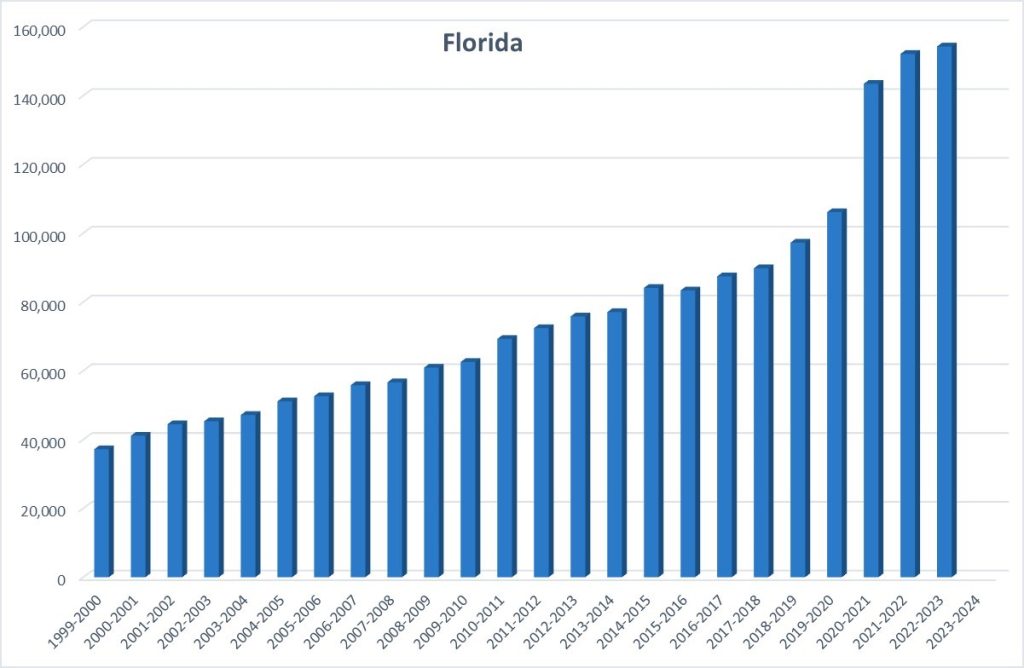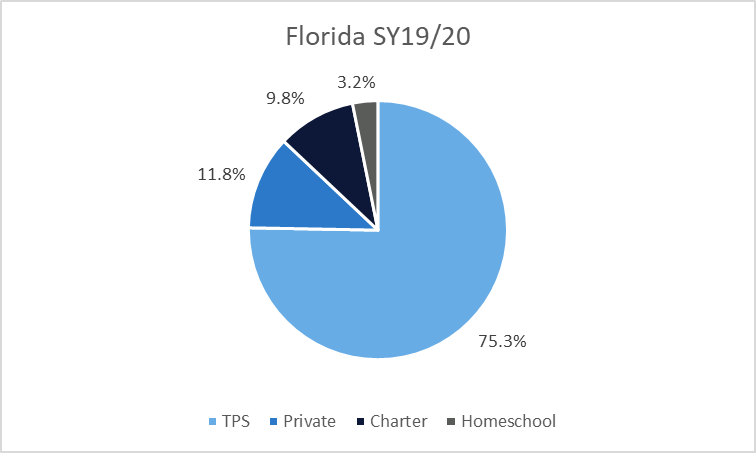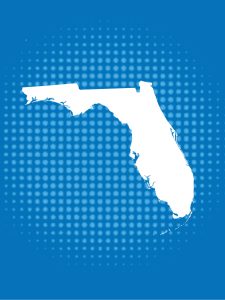Florida has a robust school choice landscape. As such, it offers an interesting look at how increased choice may impact homeschool participation.
History
Florida is in the southern United States. Legalized in 1985, Florida’s Department of Education defines home education as “a parent-directed educational option that satisfies the requirement of regular school attendance…” and states that “parents have the freedom to determine their child’s educational path and the plan for reaching their goals.” While homeschooling has always been a popular choice within Florida’s robust school choice market, homeschool participation increased during and after the pandemic. Data show a 35% increase in homeschool participation during the first year of the pandemic (2020), and participation continues to increase.
Regulation
In Florida, families with children ages 6-16, have 3 homeschooling options: (1) homeschooling under the homeschool statute, (2) homeschooling under a private school “umbrella” program, or (3) homeschooling with a private tutor. Parents leading home instruction for their children, under option 1, must file a notice of intent to the county superintendent within 30 days of beginning a homeschooling program. There is no specific educational requirement for parents, nor required subjects. Florida is one of several states that requires annual evaluation, and those scores are submitted to the local district. Under option 2, parents can enroll their children in a private school overseeing a homeschool program. Parents may hire a tutor to homeschool their children. The tutor must be a Florida-certified teacher for those grades and subjects. Similarly to option 1, private tutors must keep records related to student learning and homeschool programming. Under option 3, students are required to attend 180 days of school annually. Homeschooled students do not receive a diploma from the state. However, the GED is available to homeschooled students.
Nonpublic and homeschooled students in Florida have wide access to public school courses and extracurricular offerings, and that right is explicitly defined in the statute. For example, homeschooled students can enroll part-time or take courses at their public school; these offerings are publicly funded. It is unclear whether homeschooled students have access to SPED services.
State Data
In 2000, approximately 40,000 homeschooled students were reported by districts in Florida. By 2015, that number had doubled to over 80,000. In 2019, homeschooled students rose slowly but steadily, reaching just over 106,000. According to the 2020-2021 homeschool report from Florida’s Department of Education, there were approximately 143,000 students homeschooled in the state. Homeschool enrollment continued to increase in 2021-22, with 152,000 reported homeschooled students.

The U.S. Census estimates also indicate a large increase around the pandemic. In the spring of 2020, 5.0% of families reported homeschooling. By the fall of 2020, this increased to 18.1%, compared to the national average of 11.1%. Florida also reports homeschool participation by subgroup, including information on both the number of families and students who homeschool and participation by district. Based on U.S. Census data, our calculations indicate that about 6.82% of K-12 students in Florida were homeschooled during the 2022-23 school year, and 6.41% during the 2023-24 school year. Due to survey changes, the data from 2020 reflects the percentage of households, while the data from following years reflects the percentage of students.
Cross-Sector Comparison
During the 2019-20 academic year, 3.2% of Florida’s K-12 students were homeschooled. Homeschool participation in the state was much lower than the 11.8% of private school students. The percentage of Florida students attending charter schools was also much higher than homeschool participation, at 9.8%. In 2021-22, 4.5% of Florida’s K-12 students were homeschooled. Homeschool participation in the state was much lower than the 12.4% of private school students. The percentage of Florida students attending charter schools was also much higher than homeschool participation, at 10.6%.


School Choice Context
In addition to homeschooling, parents in Florida have various educational choices available. These options include traditional public schools with inter- and intra-district choice, vouchers, and tax credit scholarships for private schools, charter schools, magnet schools, and virtual learning programs. Florida has four private school choice programs. On March 23, 2023, the Florida Legislature passed the Universal School Choice Bill, creating an Educational Savings Account (ESA) program. Families participating in the program can use public funding to pay for private tuition or approved educational expenses. Florida’s Universal School Choice Bill provides parents with $8,000 to use for educational expenses, including tuition, tutoring, learning materials, and homeschooling.
Commentary
Florida is a state to watch. School choice options are plentiful and have been around for years, and yet homeschooling continues to grow, even exceeding post-pandemic numbers. Many wonder if some people choose to homeschool because they have limited access to other choices, but this is not the case for Florida. Many options and funding exist to remove barriers, yet more and more families continue to turn to homeschooling. On the other hand, there has been much turmoil in that state regarding education content which could be driving homeschool participation.

-
18.1% Families
Around 18.1% of families in Florida homeschooled during the height of the pandemic (Fall 2020).
-
1985 Legalized
Homeschooling was legalized in 1985 in the state of Florida.
-

-
More Information
18.1% Families
Around 18.1% of families in Florida homeschooled during the height of the pandemic (Fall 2020).
1985 Legalized
Homeschooling was legalized in 1985 in the state of Florida.

More Information
Last updated March 2025.